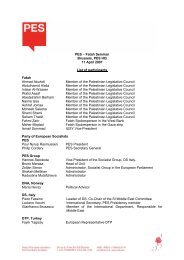Hedge funds and Private Equity - PES
Hedge funds and Private Equity - PES
Hedge funds and Private Equity - PES
Create successful ePaper yourself
Turn your PDF publications into a flip-book with our unique Google optimized e-Paper software.
52<br />
These data notwithst<strong>and</strong>ing, several commentators have criticised the claims made for hedge<br />
<strong>funds</strong>. Historically hedge <strong>funds</strong> have been a niche sector focused on specialised investment<br />
strategies that worked reasonably for a given limited amount of invested capital. The current<br />
growth of their AUM – sparked by low interest rates – could put at risk in the future ability to<br />
provide investors with the high financial returns promised in their marketing.<br />
Other commentators argue that the performance of hedge <strong>funds</strong> is overestimated already. For<br />
example, the investment bank Barclays Capital put the typical level of overstatement of returns<br />
at 1 – 6 per cent a year, depending on the index 14 . A recent study by the renowned Princeton<br />
professor Berton Malkiel <strong>and</strong> Atanu Saha reached a similar conclusion 15 . The study identifies a<br />
number of biases that exist in the published indices of hedge fund returns, biases that lead claims<br />
about investment performance to be overstated. Analysis produced by Vanguard Investments,<br />
which adjusted the annual returns of the Tremont HF index for the biases identified in Malkiel<br />
<strong>and</strong> Saha’s study, suggests that hedge <strong>funds</strong> produced returns well below those achieved by a<br />
simple portfolio of 50% bonds <strong>and</strong> 50% equities over the entire period, as well as when<br />
segmented into bull (1995-1999) <strong>and</strong> bear (2000-2002) equity markets 16 .<br />
Tremont HF index: returns<br />
without Malkiel-Saha adjustment<br />
Tremont HF index: returns<br />
with Malkiel-Saha adjustment<br />
50% Dow Jones Wilshire 5000/<br />
50% Lehman Aggregate<br />
Average annual returns<br />
1994-2003 1995-1999 2000-2002 2003<br />
11.11 18.16 4.09 15.47<br />
2.32 9.37 -4.66 6.72<br />
9.30 17.41 -2.10 17.93<br />
What reasons may there be for such an overstatement of hedge fund performance? According<br />
to Malkiel <strong>and</strong> Saha the key reasons relate to biases that they call backfill, selection <strong>and</strong> survivorship<br />
bias. Furthermore, there are additional reasons related to the lack of persistence of returns<br />
<strong>and</strong> the relatively high attrition rates amongst hedge <strong>funds</strong>. Below we describe these reasons in<br />
greater detail.<br />
– Backfill <strong>and</strong> selection bias: hedge <strong>funds</strong> are often established with seed-capital <strong>and</strong> will<br />
begin reporting on their results at a later date. Yet, backfill <strong>and</strong> selection bias can occur because<br />
hedge fund managers are able to ‘fill back’ only the most favourable investment returns into an<br />
index. This can result in returns being overstated. According to the study by Malkiel <strong>and</strong> Saha<br />
backfilled returns significantly bias the returns upwards. The arithmetic mean of the backfilled<br />
returns over the period 1994-2003 was 11.69%, while the mean for the contemporaneously<br />
reported returns was 5.95% – a difference of 5.74%.<br />
– Survivorship bias can occur because the published indices may not include the returns from<br />
hedge <strong>funds</strong> no longer in existence (known as ‘dead’ <strong>funds</strong>), or <strong>funds</strong> that exist but no longer<br />
report their results (‘defunct’ <strong>funds</strong>). Malkiel <strong>and</strong> Saha examined the effect of this survivorship<br />
14 See HF returns ‘are vastly overstated’, Timesonline, 28/02/2006<br />
15 Malkiel, B. G./Saha, A. (2005): HFs: Risk <strong>and</strong> Return, Financial Analysts Journal, Volume 61, Number 6, CFA Institute. The study draws<br />
on the TASS database.<br />
16 HF index biases, Vanguard Investments, November 2004, http://www.vanguard.com.au/library/pdf/RL%20<strong>Hedge</strong>%20Fund%20Biases%<br />
20112004.pdf




